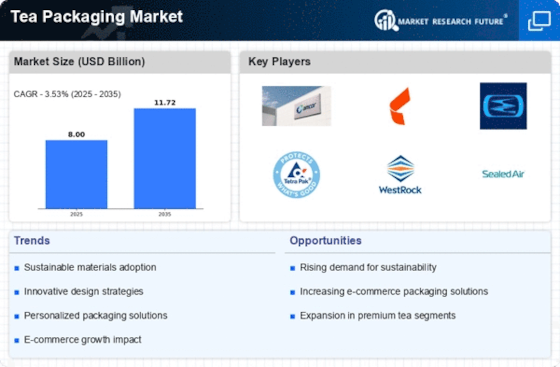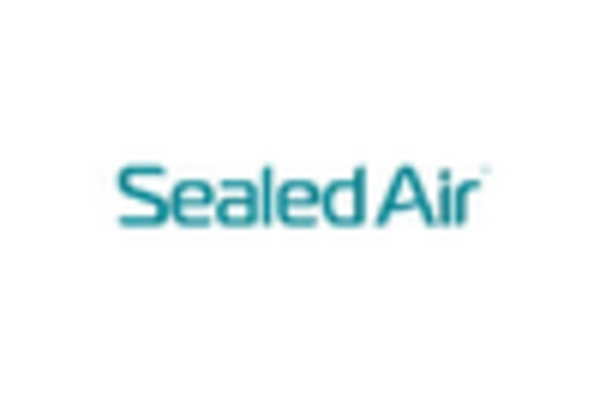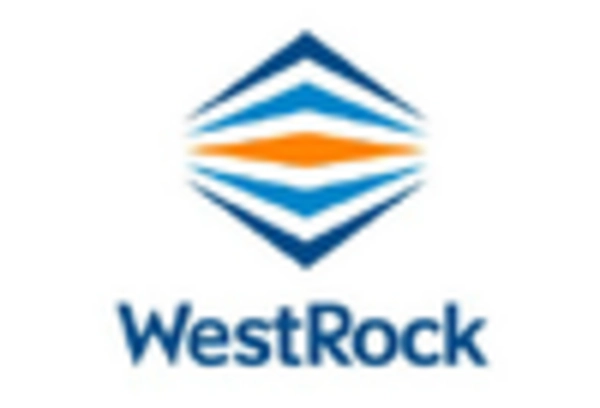Health and Wellness Trends
The growing focus on health and wellness among consumers appears to be influencing the Tea Packaging Market significantly. As more individuals seek natural and organic products, the demand for tea that promotes health benefits is on the rise. This trend is reflected in the increasing popularity of herbal and specialty teas, which are often marketed for their health-enhancing properties. Data suggests that the herbal tea segment is expected to grow at a rate of approximately 8% annually, indicating a robust market for health-oriented products. Packaging that highlights these health benefits and provides clear information about ingredients is likely to resonate with consumers. Consequently, the emphasis on health and wellness is expected to drive innovation in the Tea Packaging Market, as brands strive to meet the evolving preferences of health-conscious consumers.
Convenience-Oriented Packaging
The fast-paced lifestyle of consumers seems to be influencing the Tea Packaging Market towards convenience-oriented packaging solutions. As individuals seek quick and easy options for their tea consumption, packaging that offers single-serve portions, resealable features, and easy-to-open designs is gaining traction. This trend is particularly evident in the rise of ready-to-drink tea products, which have seen a notable increase in sales. Data indicates that the ready-to-drink tea segment is expected to grow by over 10% annually, reflecting the demand for convenience. Packaging that caters to this need not only enhances user experience but also encourages repeat purchases, thereby driving growth in the Tea Packaging Market. Manufacturers are likely to focus on developing innovative packaging formats that align with consumer preferences for convenience.
Sustainable Packaging Solutions
The increasing consumer awareness regarding environmental issues appears to drive the demand for sustainable packaging solutions in the Tea Packaging Market. As consumers become more environmentally conscious, they tend to prefer products that utilize biodegradable or recyclable materials. This shift in consumer preference has prompted manufacturers to innovate and adopt eco-friendly packaging options. According to recent data, the market for sustainable packaging is projected to grow at a compound annual growth rate of approximately 7.5% over the next five years. This trend not only aligns with consumer values but also helps brands enhance their image and appeal to a broader audience. Consequently, the emphasis on sustainability is likely to shape the future of the Tea Packaging Market, encouraging companies to invest in greener alternatives.
Technological Innovations in Packaging
Technological advancements in packaging materials and processes appear to be a significant driver in the Tea Packaging Market. Innovations such as smart packaging, which incorporates QR codes and NFC technology, allow consumers to engage with products in new ways. These technologies can provide information about the tea's origin, brewing instructions, and even sustainability credentials. Furthermore, advancements in materials science have led to the development of packaging that extends shelf life and preserves flavor, which is crucial for maintaining product quality. The integration of technology in packaging is projected to enhance consumer engagement and satisfaction, potentially leading to increased sales. As the industry evolves, it is likely that more companies will invest in these technological innovations to remain competitive in the Tea Packaging Market.
E-commerce Growth and Packaging Adaptation
The rapid growth of e-commerce appears to be reshaping the Tea Packaging Market, as more consumers turn to online shopping for their tea purchases. This shift necessitates packaging that is not only appealing but also durable enough to withstand shipping and handling. Companies are increasingly focusing on designing packaging that protects the product while also being visually attractive to enhance the online shopping experience. Data indicates that e-commerce sales in the tea sector are projected to increase by over 15% annually, underscoring the importance of adapting packaging strategies to meet this demand. As the online market expands, it is likely that brands will invest in innovative packaging solutions that cater specifically to e-commerce, thereby driving growth in the Tea Packaging Market.

















Leave a Comment